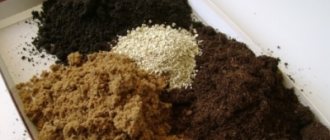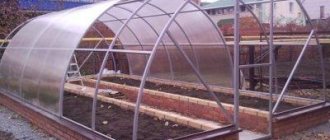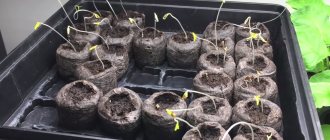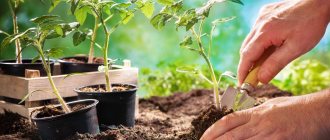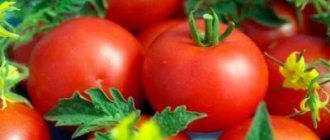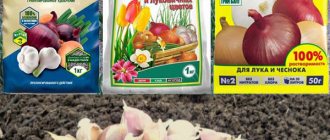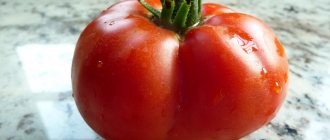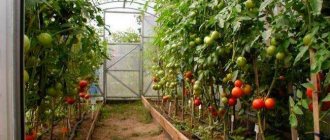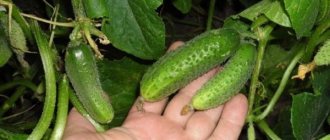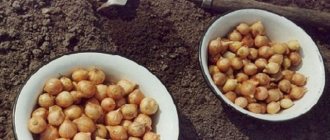By choosing a place to plant tomatoes, properly preparing the seedlings and organizing high-quality care for the sprouts, you can get a useful harvest that will bring the desired profit. Moreover, the farmer will be able not only to earn money, but also to provide personal needs with products!
Tomato is one of the favorite vegetables, which is especially common in Russia. Tomatoes have received well-deserved recognition not only for their rich taste, but also for their ability to be useful when preserved. Tomato pastes, salted and pickled tomatoes are a traditional dish on the table in any family. What would a feast be without salted tomatoes?
Tomato is traditionally involved in many dishes that are firmly entrenched in our menu. One of the most important, namely Russian borscht, is not possible without tomato paste. Many housewives have no idea how to stew meat and vegetables without fresh tomatoes or pasta. And among many peoples, tomatoes are the main dish, raw, dried, stewed, pickled or salted. The scope of application in cooking is huge: excellent juice is obtained from tomatoes, thick pastes are made, which are perfectly stored in canned form and are available all year round, tomatoes are canned whole or in the form of salads, they are frozen and dried. The only thing you can’t do with tomatoes is keep them fresh for a long time. Like any vegetable, tomato is not suitable for long-term storage, only processing.
Fresh tomatoes are incredibly rich in vitamins and beneficial microelements. Moreover, this vegetable contains serotonin, a joy hormone that copes well with depression. As strange as it may sound, banal tomatoes will help with a bad mood. It is also known as an excellent antioxidant, which means that it cleanses the body of harmful substances simply and effectively, without medical intervention.
What else is good about Senor Tomato? Tomato peel has an excellent effect on intestinal motility, regulating all metabolic processes in the body, and the seeds of the fruit are known as an excellent natural blood thinner. Regular consumption of fresh tomatoes is recommended for preventive purposes at the risk of thrombosis.
Well, one cannot help but note the rich set of vitamins contained in this unique vegetable - vitamins B, A, PP and K. Among the important microelements - sodium, manganese, iron, magnesium and zinc.
Oddly enough, even salted tomatoes are useful, because they are an excellent hangover cure! After such praise, the desire to grow this valuable product in your garden should appear instantly! Are tomatoes difficult to grow? We'll talk about this further.
How to grow and what you need to know
Once the issue of planting tomatoes has been decided, it is worth planning the entire process. First of all, you need to know what conditions are required.
- Choose the right area.
Tomato is a rather demanding plant. It loves the sun, but does not tolerate wind and drafts. Therefore, when choosing an area for tomatoes, it is necessary to adhere to these rules - open sun and minimal ventilation. It should not be a slope or lowland, especially if it is always damp due to the proximity of groundwater, the area should be flat.
- Determine the type of soil.
Tomatoes are extremely demanding on soil. Sandy loams with plenty of organic fertilizers are ideal for growing. Heavy soils, as well as cold and wet ones, are absolutely not suitable. Excessive acidity also harms this vegetable. One of the most important factors in which tomatoes will not grow is cold. Everything else can be corrected using new and classic agricultural technologies.
- Prepare the seedlings correctly.
Tomatoes are planted in open ground as seedlings. Seedlings are obtained from seeds. The process of preparing seedlings will be described below.
- Proper care.
During growth and ripening, tomatoes require attention. To get large and juicy fruits, the crop must be looked after - weeding, removing weeds, loosening the soil in the beds and watering regularly.
Preparing nutritional mixture at home
You can prepare a nutrient mixture for growing tomatoes yourself. There are several ways.
For the first option, you will need to take the following components in the proportion 1:1:0.2:1:
- peat;
- sand;
- wood ash;
- turf soil.
For the second option, take the following components in the ratio 4:1:0.5:0.2:
- peat;
- turf;
- sawdust;
- mullein.
For the third option you will need to take the following components:
- wood ash;
- sawdust (steamed);
- sand;
- 1 tbsp. spoon of nitrogen fertilizing.
All ingredients are mixed for even distribution.
The fourth option involves mixing the following components:
- turf land;
- manure;
- sand;
- peat;
- 3 tbsp. spoons nitrogenous fertilizer.
Preparation and mixing is carried out in a bucket of water.
Another option for those who want to prepare their own nutritional mixture and who prefer organic:
- soil from the garden;
- forest land;
- 1 part humus;
- 1 part fine sand.
The mixture of components is passed through a sieve, 250 ml of ash and 100 g of chicken egg shells are added (crushed chalk is also suitable).
Preparing the soil for planting tomato seeds
The first thing a gardener needs to do in early spring is plant seedlings. Of course, it can be purchased, but a true gardener will grow the seedlings personally. He will select the variety himself or use seeds from the previous harvest. How to prepare the soil for planting tomato seeds? Firstly, soil for seeds can be purchased at a specialty store. Such soil will already be prepared - it will contain all the necessary substances. Then it will be enough to simply divide the soil into containers and plant seeds in them. Plant seeds for future seedlings at the very beginning of spring, choosing the brightest place in the house - window sills on the sunny side. Often special lamps are installed above the seedlings, then the choice of location is not important, although there is still one thing - it should not be cold in this place and there should be no drafts. The ideal temperature for seedlings is 20-24 degrees.
Remember that the future harvest depends on the quality of seeds and, accordingly, seedlings!
The importance of soil for seedlings
Just as a theater begins with a hanger, so does a seedling begin with the soil. A high-quality earthen mixture for its cultivation is the key to a future good harvest. If it turns out to be not good enough, then the tomatoes will turn out to be sick or weak and we will not get a full harvest. Or even worse, the seedlings will die and we will have to start all over again or buy them at the market.
You can’t just take a shovel and dig up garden soil or bring soil from a greenhouse - with almost 100% probability nothing good will come of it. The soil for tomato seedlings is prepared from several components that require appropriate preparation. Only large farms grow tomato seedlings on clean peat, pre-treating it and saturating it with fertilizers and special additives. But they have appropriate industrial equipment for these purposes.
And do we really need tomatoes that are pumped full of chemicals even before planting in the soil? It is better to spend some time and prepare the soil for tomato seedlings yourself.
Preparing seeds for seedlings
Before planting, the seeds are prepared several days in advance - they are immersed in water and everything that floats is removed. A high-quality seed will remain at the bottom. The water is drained along with the garbage, and the remaining seeds must be treated with a solution of potassium permanganate:
- make a solution of potassium permanganate to get a thick purple tint.
- Immerse the seeds in the resulting solution for 25 minutes.
- after disinfection, the seeds are soaked in ordinary water until they swell, for about 10 hours.
When the planting material is ready, two or three seeds are planted in the ground. You can buy containers for planting, for example small peat pots, which are then planted in open ground. You can use disposable cups or cut off the bottoms of plastic bottles. Here the imagination of gardeners is not limited by anything.
It is necessary to plant to a depth of one centimeter, not deeper, otherwise the seed may not break through. During the growth of seedlings, it is necessary to ensure that the plant does not dry out, but is not flooded with water. It is ideal to water by spraying moisture to maintain uniformity.
As soon as the seeds have sprouted to a height of approximately 5-7 centimeters, they need to be planted or simply thinned out. You need to carefully examine the seedlings, remove unhealthy plants, and plant the necessary ones again one by one. This process is called picking.
How to choose soil
Today, many companies produce soil for seedlings. However, the product is not always as high quality as customers would like. Therefore, you need to be able to choose a suitable soil mixture.
Healthy! Before planting tomato seeds, it is advisable to saturate the soil with air - spread it in a thin layer on a baking sheet and let it “breathe”.
First of all, you need to pay attention to the structure. It should be homogeneous - without pebbles, pieces of wood and other foreign impurities. It will be better if the fraction is even, and all components are well mixed and have the same color.
Fraction size also matters. If the particles are too large, the soil will dry out very quickly - the moisture evaporates from it quickly. On the contrary, very fine soil impairs air access to plant roots, also leading to a rapid increase in soil acidity, which is not good for all crops.
The soil must be homogeneous
Don't forget about the expiration date. It is believed that over time, the earth may lose valuable qualities - if storage conditions are not met, then the microorganisms living in it will simply die. Therefore, it is advisable to use soil no older than three years.
Finally, it is important to pay attention to the purpose of the soil. As mentioned above, every culture has certain preferences. For example, soil for seedlings of tomatoes and peppers is not suitable for flowers or cucumbers.
Preparing the soil for planting seedlings
The process of preparing soil for planting tomato seeds differs from the process of preparing open ground. In the first case, it is enough to buy a few kilograms of ready-made soil in the store. But the growing area itself must be prepared carefully and in two stages:
- prepare the soil in the fall.
- prepare the soil in the spring.
In the fall, after harvesting, the land is carefully cleared of plant remains and debris. Then it is dug using the deep method, to a depth of 20-25 centimeters, with the formation being thrown over. If the soil is noticeably heavy, then it is necessary to add sand at this time - 1 bucket per square meter. The soil should be fairly light and fertile.
Increased acidity is “treated” with lime in the amount of half a kilogram per square meter. Liming the soil is done at the time of digging.
In the fall, organic fertilizers are also applied - manure, compost or humus. The treated soil is left in this form for the winter - frosts should destroy all pathogenic bacteria from the surface of the earth, and fertilizers will be able to be absorbed evenly into the soil during the melting of snow and spring rains.
In spring, the soil is also treated before planting. Mineral fertilizers are applied during spring loosening or digging of the earth. Mineral fertilizers are applied into the soil to a depth of 15-20 centimeters per square meter:
- 20 grams of saltpeter
- 50 grams of superphosphates
- 20 grams of potassium chloride.
Good digging and loosening are extremely important because tomatoes have a weak root system and need to take all the substances from the soil in a limited space. Uniformity and good oxygen saturation of the soil are important. In this case, the plant will develop well and give a good harvest.
Requirements for soil composition and acidity
Regardless of when the crop is planted, in spring or autumn, specific requirements are put forward for the composition of the soil.
The soil should be neutral or slightly acidic (planting tomatoes in acidic soil is not recommended). Acidity cannot be higher than 7. Otherwise, the chance of seedling death increases. You can check this indicator at home. The simplest way is to use vinegar or ready-made dough (other options for independently testing the soil for acidity are given below).
The soil must contain the following minerals:
- nitrogen - with its deficiency, the leaves of the crop become small and pale;
- phosphorus - lack of mineral provokes slow growth and formation of fruits;
- potassium - a deficiency of the mineral is indicated by a bronze border on tomato leaves;
- calcium - a lack of a mineral can lead to the death of the growing point.
Expert opinion
Stanislav Pavlovich
Gardener with 17 years of experience and our expert
Ask a Question
Attention! Soil enrichment must be done correctly. The limit content of each mineral in the soil is 400 mg per 1 liter.
Also, the soil should be loose. This ensures air access to the root system of seedlings. Another important condition is hygroscopicity. The soil for growing crops must absorb and retain liquid.
The soil should not contain clay, stones, weed residues and heavy metals.
Required Components
There are many soil options for growing tomatoes:
- High or lowland peat. The earth is characterized by neutral acidity. Not rich in minerals. Used as a soil loosener.
- Rotted leaf compost. Used as a baking powder. Improves air and water permeability of the soil.
- Sawdust.
- Wood ash is a source of many minerals.
- Lime (quicklime). Used to reduce soil acidity.
- Chernozem.
- Coconut fiber. Protects the soil from fungus. Used to reduce acidity levels.
- Sphagnum moss. Increases the permeability of the soil. Acts as a barrier against bacteria.
- Superphosphate.
- Humus. Rotted manure, which contains a large amount of minerals necessary for the culture.
- Sod soil is land taken from meadows and pastures.
- Coarse sand (river), without clay and stone impurities. Used as a leavening agent.
- Agropelite is a rock similar in composition to river sand.
- Vermiculite. Provides the soil with oxygen. Prevents the development of fungal diseases.
See also: The best varieties of tomatoes resistant to late blight for growing in the Moscow region
What should not be included
It is prohibited to use organic matter that is in the process of decay. At this moment, a large amount of heat is released, which can destroy the planting material. Even if the seeds germinate, they will die in high temperatures.
Clay admixtures should also not be used. These components make the earth dense and heavy.
Heavy metals quickly accumulate in the soil, so land for cultivation should not be taken near busy roads or near chemical plants.
Why is it better to prepare seedling soil yourself?
It is not surprising that many experienced gardeners prefer to make their own soil. This has many advantages. Having purchased the initial components, you can easily mix them with just the right substrate that is ideal for growing certain plants.
In addition, it can be additionally subjected to appropriate processing. Yes, you will have to spend extra time and effort. But this guarantees that the soil in the seedling containers will be much better than in a regular plot. This means that the likelihood of getting a rich harvest increases significantly.
Mistakes gardeners make when preparing and caring for soil for tomatoes
Some gardeners underestimate the importance of soil acidity for growing tomatoes and its quality composition. The most common mistakes in soil care are:
- lack of acidity control. Tomatoes will not produce a bountiful harvest if you do not monitor the acidity. Tomatoes prefer neutral soils;
- unsystematic application of organic fertilizers. The addition of mullein, manure and compost changes the acidity of the soil. You should follow the recommendations of agronomists on the timing of organic matter application;
- failure to apply ready-made fertilizers or natural nutritional infusions. Neglecting to feed tomatoes also has a detrimental effect on their development and fruit formation. The soil is quickly depleted and the plant is deficient in nutrients;
- fertilization with compost of inadequate quality. Adding compost to the soil, which uses unacceptable components, affects the quality of the soil. When organizing a compost pit, you should not store pet feces, colored glossy paper, or acidic peat in it. You should also give the compost time to rot;
- adding fresh manure to the soil. Using fresh mullein or bird droppings in their pure form can increase the acidic or alkaline reaction of the soil. It is necessary to wait time for the chemical reactions of neutralization and decomposition to occur in the manure.
Gardeners should also pay attention to soil moisture.
Method for determining soil acidity using indicator plants and litmus paper
The soil level is characterized by the “wild” plants that exist on the site. If prevail:
- Horsetail,
- Horse sorrel,
- Buttercup is caustic,
- Large leaf plantain,
- Three-leaf oxalis,
- European Weekend,
- Chicken millet,
- The knotweed is a bushy plant, so the natural soil on the site is acidic.
If caustic buttercup predominates on the site, then the soil is acidic.
When they grow profusely:
- Field bindweed,
- Plantain lanceolate,
- Field mustard,
- Cleavers,
- Spreading quinoa
- Sandman is white - this means that the soil is alkaline.
Both types of soil require neutralization, that is, it is necessary to add the necessary substances so that the pH level becomes 6.5.
The soil should not contain
The soil should not contain dangerous salts or toxic impurities. The same applies to foreign microorganisms, as well as fungal spores, weed seeds and eggs of harmful insects.
But this is where difficulties arise. On the one hand, the soil should not be sterile, because nothing will grow on it at all. So, beneficial microorganisms are definitely needed here. On the other hand, without special equipment it is impossible to determine whether there are foreign impurities in the soil. This has to be done experimentally, that is, an element of risk, alas, is always present.
Choosing a place for tomatoes
A well-lit place on the site should be allocated for tomato beds. It is better that the predecessors are onions, carrots or cucumbers. But if other representatives of the nightshade family grew in this place, you can use such a plot for tomatoes only after 3 years have passed from the moment they were planted.
It has been noticed that tomatoes feel great next to strawberries - the yield of both crops increases significantly, and the fruits and berries themselves grow larger.
What soil is best for tomatoes?
Soil conditions when growing tomatoes? The requirements for the soil when cultivating tomatoes are determined by the needs of the plants for their normal growth and development. The following criteria are used to assess soil quality:
- Acidity level.
- Structural characteristics of the soil.
- Parameters related to humidity.
For effective growth and fruiting, plants need vitamins and minerals.
The plant must develop a strong root system. This will allow him to take from the ground in the required quantity everything he needs. But for this it is necessary that the soil itself meets certain criteria.
What is the importance of soil acidity when growing tomatoes?
Acidity indicators are perhaps one of the most important criteria for the conditions when cultivating tomatoes. This value should normally be in the range from 6.0 to 6.8. These numbers were not chosen by chance. It has been experimentally established that it is at these values that the plant will grow and develop normally.
Tips for gardeners
Finally, it will be useful to give a few simple tips, following which will always ensure a rich harvest:
- Instead of sand, you can use sawdust when making soil - they increase acidity and also make the soil looser.
- Humus can be replaced with compost - it also contains a large amount of useful substances necessary for the active growth of seedlings.
- 20 days before planting the seeds, the soil must be moistened (the soil clenched in a fist should not seep through your fingers, but also should not crumble) and left in a warm place.
It is quite possible to make soil for seedlings yourself. This means that nothing will prevent you from getting a rich harvest of delicious tomatoes and peppers.
How to deoxidize the soil
So, what soil acidity should be for tomatoes is known - no more than 6.5. If the pH value exceeds the norm, the tomatoes will become sick. You can determine the acidity of the soil yourself, just look at the weeds that grow on it. Creeping wheatgrass, an almost indestructible pest, grows in areas with low pH levels. But woodlice feels good in very acidic soil, so thickets of this grass clearly indicate that the soil for tomatoes needs to be deacidified.
